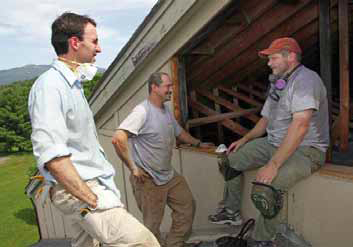Thermal Efficiency Efforts

Middlesex residents after a long day of weatherizing the Rumney Memorial School.
Vermont, as the rest of the nation, is facing unprecedented increases in fuel oil prices—with fuel oil prices more than doubling in the last decade. Tightening up homes by stopping air leakage is an effective way to save energy. Some weatherization techniques can help your family pay for an upfront investment of weatherization materials in one heating season and many can be easily installed in a few hours by an individual. No-cost or low-cost weatherization measures – such as caulking and weather-stripping – coupled with education for behavior changes can reduce fuel costs between 5-15 percent!
In the early 1980s, Vermont implemented a statewide weatherization campaign, known as “Button-Up Vermont” which organized weatherization activities in more than 50 Vermont communities. Today, this model is again gaining traction at the local and state level, offering a unique opportunity for Vermonters to implement self-help energy efficiency measures to reduce their energy use. At the same time, residents can learn about how their homes lose energy, the value of having an energy audit, and the enormous savings available from implementing extensive energy retrofit measures.
Heating Efficiency Success Stories — click here to learn about municipal and residential thermal efficiency success stories!
How To Do It?
A Community Weatherization Project (CWP) is a locally designed and administered community energy conservation program. The scope of the project may vary within each community, depending upon local resources, leadership, and creativity. The major goal of a CWP is to educate and mobilize a significant number of citizens to undertake low-cost conservation measures in their homes.
A good example of a successful CWP is the work of Bob Walker of the Sustainable Energy Resource Group, and the Thetford Energy Committee. They teamed together to utilize a door-to-door model that has proven to be very promising. You can read about their efforts by clicking the image in the sidebar.
A CWP usually occurs during a concentrated 2-3 month effort; often in the fall as people prepare for the winter. Keeping the program simple and clear are the keys to success. The main focus of a CWP should be clearly evident and easy to understand in all publicity, outreach, and activities of the project. A CWP can help build a local constituency of leadership and residents to address more comprehensive energy problems and needs over the long term.
A low cost or no cost CWP revolves around promoting a series of workshops designed to cover the following topics:
• Conservation measures which involve only minor lifestyle adjustments and no money;
• Areas in the home with air leakage;
• The installation of materials to block air leakage.
Information And Resources
- Efficiency Vermont: For a list of energy auditors, energy efficiency tips, and other efficiency resources.
